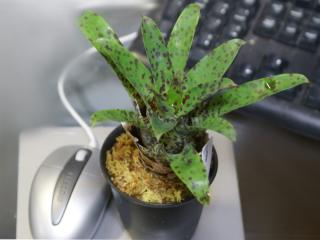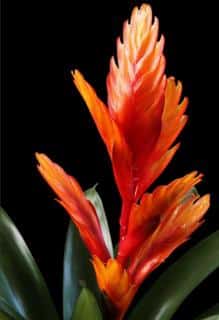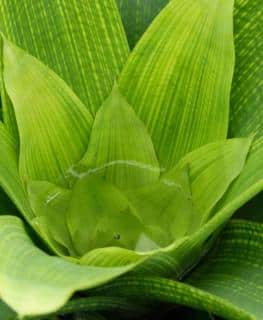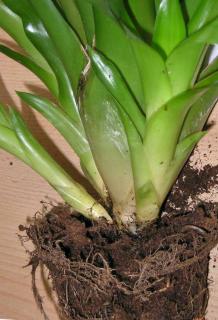

In the Bromeliaceae family, fiery Vriesea really stands out.
A summary of Vriesea facts
Name – Vriesea
Family – Bromeliaceae
Type – indoor plant
Height – 12 to 20 inches (30 to 50 cm)
Exposure – light but not direct light
Foliage: evergreen – Flowering: end of winter or summer (species)
As original, colorful and exotic as its cousins, Vriesea is simply an astounding indoor plant. Native to South America, its deep dark green foliage and beautiful orange or red blooming are truly appealing.
Vriesea, like all other Bromeliaceae plants, requires soil that is sufficiently rich and very well-drained to grow well.
 Special Bromeliaceae soil mix is the best solution but you can also opt for flower plant soil mix and layer the bottom with a thick drainage medium.
Special Bromeliaceae soil mix is the best solution but you can also opt for flower plant soil mix and layer the bottom with a thick drainage medium.
If you wish to repot your vriesea, wait for the blooming to end.
Vriesea requires temperatures that oscillate between 64 and 75°F (18 to 24°C) and never drop below 57°F (13°C).
 The temperature of a house or apartment is thus ideal for growing a vriesea.
The temperature of a house or apartment is thus ideal for growing a vriesea.
An ideal location for your vriesea is in a spot where there isn’t any direct sun on the plant.
Regular but moderate watering is called for because Vriesea doesn’t usually require a lot of water.
 Keep the soil mix barely moist and check that water drains properly.
Keep the soil mix barely moist and check that water drains properly.
Provide liquid leaf plant fertilizer more or less once a month to extend the blooming to the maximum.
To retain a certain moisture level, it is best to put the pot atop a bed of clay pebbles or little stones wallowing in water. Evaporation will help recreate the living environment of their native habitat without needing to overwater.
Limit the watering and wait for the soil to be thoroughly dry before watering again.
Most diseases targeted are common indoor plant diseases, red spider mites, scale insects, aphids and also powdery mildew.
 There’s a reason why the Vriesea flower is so stunning: a plant will only bear a single flower in its entire lifetime!
There’s a reason why the Vriesea flower is so stunning: a plant will only bear a single flower in its entire lifetime!
However, as soon as pups or small offshoots start forming, you can separate them from the mother plant and nurture them. These will give you a new flower when they have grown a bit larger.
So it isn’t possible to make the same plant bloom again. But all the offspring you can divide from the main plant will be exact clones of the first one, flower included!
The Vriesea flower, commonly called Flaming Sword, is truly an outstanding houseplant that will lend your house a definite urban jungle touch!
Read also:
A fabulous indoor plant, vriesea is native to tropical forests and is rendered vulnerable by the dry air in our homes.
Spraying the plant regularly with rainwater and placing the pot atop a bed of wet gravel will help re-create the plant’s natural habitat.
Where can I purchase these I am in West Australia
Hi Moyra, there are quite a few suppliers (Nature & Garden doesn’t sell). Physical stores in West Australia include Red Rock Nursery (Forrestfeild) and Benara Nurseries (Carabooda). Online, some stores will deliver throughout the country, like AusBroms (New South Wales), GardensOnline (South Australia) and Australian Plants Online (Queensland).